Which caviar is able to increase hemoglobin in the blood — consider the 3 main varieties
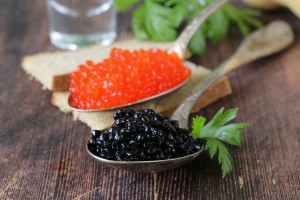 With anemia, doctors always recommend including seafood in the diet, in particular, red and black caviar. They say they increase hemoglobin well, help normalize blood viscosity.
With anemia, doctors always recommend including seafood in the diet, in particular, red and black caviar. They say they increase hemoglobin well, help normalize blood viscosity.
Wouldn't it be better to use apples and pomegranates for this? After all, they also contain a fairly large amount of iron. Or is caviar better suited for the treatment and prevention of anemia? What do nutritionists say about this? Which varieties are best consumed with low hemoglobin levels?
How does it affect hemoglobin?
Many foods contain large amounts of iron. Namely, this trace element is the main component of hemoglobin cells and it is iron-rich products that increase it.
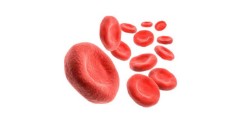 In red and black caviar, his – about 3 milligrams of iron per 100 grams of product
, which is almost 30 times more than in
apples
.
In red and black caviar, his – about 3 milligrams of iron per 100 grams of product
, which is almost 30 times more than in
apples
.
However, not all of the iron consumed is digested. In particular, it depends on the amount of folic acid in the body. If there is a deficiency, iron is practically not absorbed.
Caviar also contains a fairly large amount of folic acid (aka vitamin B 9 ). That is why caviar significantly raises hemoglobin, and at the same time helps to absorb iron from other products faster.
Which variety is most useful?
There are many different types of caviar. Some of them are more beneficial for the blood, others are less so. Below we will look at 3 species containing the largest amount of iron.
1. Black
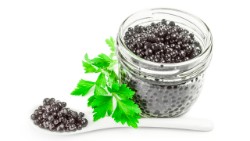 On average, 2.5 milligrams of iron per 100 grams of caviar. The average daily norm of this trace element is about 10 mg for an adult, and about 6 mg for children (up to adolescence).
On average, 2.5 milligrams of iron per 100 grams of caviar. The average daily norm of this trace element is about 10 mg for an adult, and about 6 mg for children (up to adolescence).
Black caviar comes in several varieties. The most useful for increasing hemoglobin is not pasteurized from slaughtered fish. Less useful is pasteurized dairy (that is, which is extracted not yet fully ripe).
Also black caviar will be useful for anemia , since its use stimulates the work of the bone marrow (where blood is synthesized).
2. Red
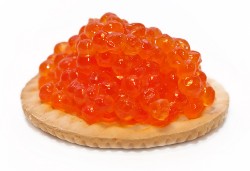 The effect of its use is almost identical to black caviar – hemoglobin increases significantly as a result.
The effect of its use is almost identical to black caviar – hemoglobin increases significantly as a result.
Moreover, the nutritional value of both red and black caviar is almost identical, including in terms of the amount of folic acid. Only black is rarer and, accordingly, costs much more.
Nutritionists also claim that the most useful red caviar is from salmon. This is what is mainly produced in the Russian Federation (industrial salmon fishing is established in Kamchatka).
3. Yellow
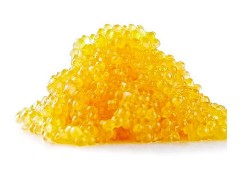 Yellow caviar (it is correct to call it "partial") is the most common in cooking, as it occurs in almost all varieties of freshwater fish. It also contains iron, on average – 0.6 – 1 mg per 100 grams of the finished product.
Yellow caviar (it is correct to call it "partial") is the most common in cooking, as it occurs in almost all varieties of freshwater fish. It also contains iron, on average – 0.6 – 1 mg per 100 grams of the finished product.
Folic acid is also available (up to 0.01 mg). Accordingly, the use of such caviar also increases the concentration of hemoglobin, although not as much as black and red.
It is also valuable due to the high content of omega-3 acid, which increases the bioavailability of iron for the human body, and at the same time reduces the concentration of cholesterol in the blood (this minimizes the likelihood of anemia, anemia).
What about the fish itself?
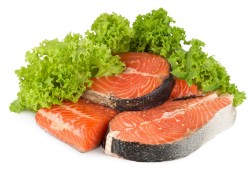 Fish meat contains a small amount of iron. But it contains omega-3 and omega-9 acids, which help the body absorb iron and stimulate blood production in the bone marrow. In this regard, more fatty fish varieties are considered useful
(including the red one).
Fish meat contains a small amount of iron. But it contains omega-3 and omega-9 acids, which help the body absorb iron and stimulate blood production in the bone marrow. In this regard, more fatty fish varieties are considered useful
(including the red one).
Freshwater fish is less useful in this regard. Although in the same carp, omega-3 acids are only 1.5 times less than in red fish. But it also contains folic acid, as well as iodine, magnesium, potassium, and silicon, which indirectly also help the body produce blood and stimulate the rise of hemoglobin.
Useful Video
We offer to view these videos:
Conclusion
In total, caviar is extremely useful for anemia, as it improves blood composition better than any other products. An increase in hemoglobin is achieved due to the presence of both iron and folic acid in its composition. It is also recommended to use it for pregnant women – it helps to normalize the hormonal balance, and also reduces the risk of developing pathologies of the nervous tube of the unborn child.





